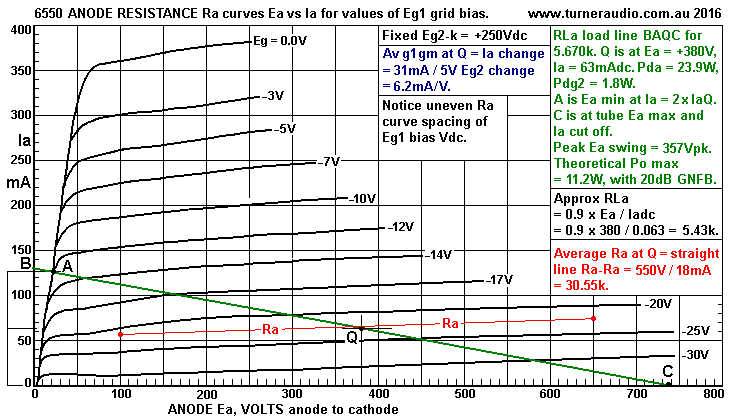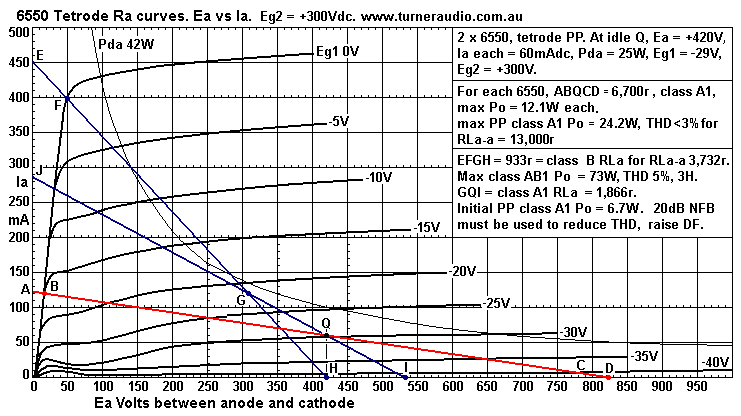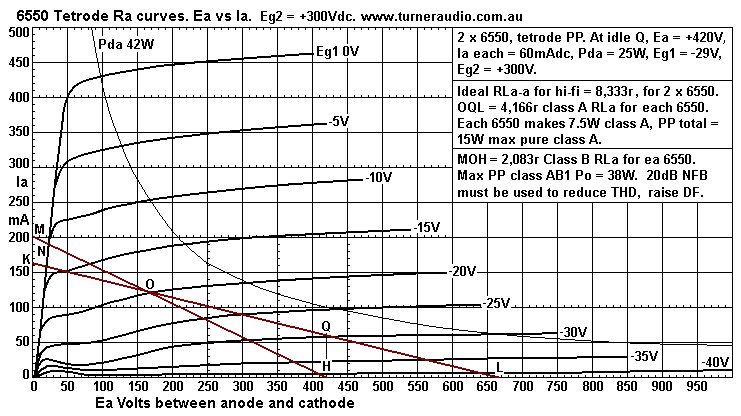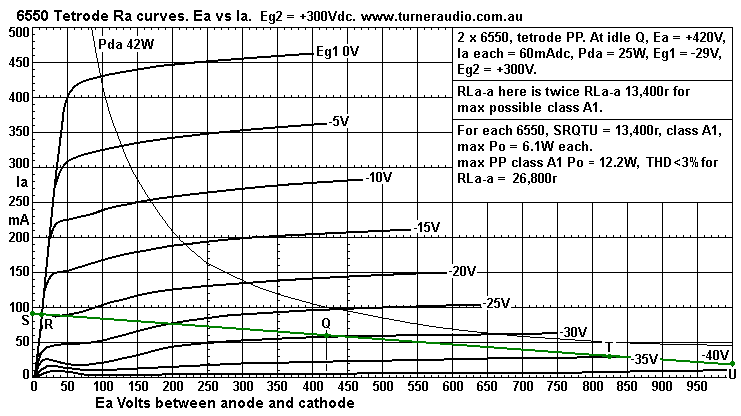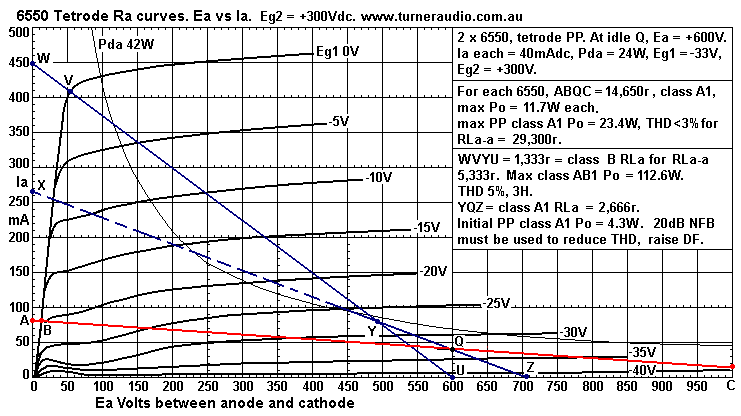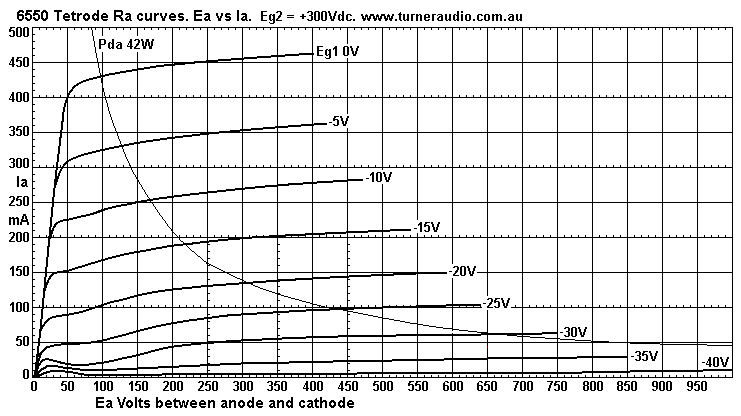
| Tube type Number |
Pda rating 1 tube tetrode W |
Pda factor for idle Pda W |
Best idle Pda W |
Ea at idle Vdc |
Iadc at idle, 1 tube, mAdc |
Class A only. RLa-a 1.9 x Ea / Ia |
Class A Max Po anodes W |
Class AB1 Hi-fi RLa-a 0.8 x Ea/Iadc |
Class A & AB1 Hi-fi max Po anodes W |
Class AB1 Lo-fi Min RLa-a Ia pk 450mA |
Class A & AB1 Max Po anodes W |
Eg2 Idle +Vdc |
| 6550, KT88 |
42W |
0.6 |
25.2 |
350 |
72 |
9k3 | 24 | 3k9
|
10 41 | 2k2
|
4.9 56 | 300 |
| 6550, KT88 |
42W |
0.6 |
25.2 |
400 |
63 |
12k0 | 24 |
5k1
|
10 47 | 2k6
|
5
69 |
330 |
| 6550, KT88 |
42W |
0.6 |
25.2 |
450 |
56 |
15k3
|
24 |
6k4 | 10 49 | 3k2
|
5
76 |
330 |
| 6550, KT88 | 42W | 0.6 |
25.2 |
500 |
51 |
18k6 | 24 |
7k8 |
10
52 |
3k6 |
5 82 | 330 |
| 6550, KT88 | 42W | 0.55 |
23.1 |
550 |
42 |
24k9 | 22 |
10k5 |
9.3
49 |
4k0 |
3.5 101 |
350 |
| 6550, KT88 | 42W | 0.5 |
21.0 |
600 |
35 |
35k6 | 20 |
13k7 |
8.4
46 |
4k5 |
4.4 111 |
375 |
| |
||||||||||||
| KT90 |
50W |
0.6 |
30.0 |
350 |
85 |
7k8 | 28 |
3k3 |
11.9
43 |
2k2 |
7.9 56 |
300 |
| KT90 |
50W |
0.6 |
30.0 |
400 |
75 |
10k1 | 28 |
4k2
|
11.8
59 |
2k6 |
7.3 69 |
330 |
| KT90 |
50W |
0.55 |
27.5 |
450 |
61 |
14k0 | 26 | 5k9
|
10.9
51 |
3k1
|
5.7 79 |
330 |
| KT90 |
50W |
0.55 |
27.5 |
500 |
55 |
17k3
|
26 |
7k3
|
11.0
53 |
3k6
|
5.4 88 |
330 |
| KT90 | 50W |
0.5 |
25.0 |
550 |
45 |
23k2
|
23 |
9k7
|
9.7
53 |
4k0
|
4.0 101 |
350 |
| KT90 | 50W |
0.5 |
25.0 |
600 |
42 |
27k1
|
23 |
11k4
|
9.7
55 |
4k5
|
4.0 111 |
375 |
| Tube type Number |
Pda rating 1 tube tetrode pentode W |
Pda factor for idle Pda W |
Best idle Pda W |
Ea at idle Vdc |
Iadc at idle, 1 tube, mAdc |
Class A only. RLa-a 1.9 x Ea / Ia |
Class A Max Po anodes W |
Class AB1 Hi-fi RLa-a 0.8 x Ea/Iadc |
Class A & AB1 Hi-fi max Po anodes W |
Class AB1 Lo-fi Min RLa-a Ia pk 350mA |
Class A & AB1 Max Po anodes W |
Eg2 Idle +Vdc |
| EL34,6CA7 |
25W |
0.7 |
17.5 |
300 |
58 |
9k8
|
16.5 |
4k1
|
6.9 31 | 2k7
|
4.5 40 | 300 |
| EL34,6CA7 | 25W |
0.7 |
17.5 | 350 | 50 |
13k3 |
16.6 |
5k6
|
7.0
34 |
3k3
|
4.1
50 |
350 |
| EL34,6CA7 | 25W |
0.7 |
17.5 | 400 |
44 |
17k3 |
16.7 |
7k3
|
7.0
37 |
3k8
|
3.6
59 |
375 |
| EL34,6CA7 | 25W |
0.6 |
15.0 |
450 |
33 |
25k9 |
14.1 |
10k9 |
5.9
33 |
4k4 |
2.4
67 |
400 |
| Tube type Number |
Pda rating 1 tube tetrode pentode W |
Pda factor for idle Pda W |
Best idle Pda W |
Ea at idle Vdc |
Iadc at idle, 1 tube, mAdc |
Class A only. RLa-a 1.9 x Ea / Ia |
Class A Max Po anodes W |
Class AB1 Hi-fi RLa-a 0.8 x Ea/Iadc |
Class A & AB1 Hi-fi max Po anodes W |
Class AB1 Lo-fi Min RLa-a Ia pk 350mA* |
Class A & AB1 Max Po anodes W |
Eg2 Idle +Vdc |
| KT66, 6L6GC |
25 |
0.7 |
17.5 |
300 |
58 |
9k8
|
16.5 |
4k1
|
6.9 31 | NA
|
NA
|
300 |
| KT66, 6L6GC | 25 |
0.7 |
17.5 | 350 | 50 |
13k3 |
16.6 |
5k6
|
7.0
32 |
3k9
|
4.8
42 |
350 |
| KT66, 6L6GC | 25 |
0.7 |
17.5 | 400 |
44 |
17k3 |
16.7 |
7k3
|
7.0
31 |
4k7
|
4.5
45 |
375 |
| KT66, 6L6GC | 25 |
0.6 |
15.0 |
450 |
33 |
25k9 |
14.1 |
10k9 |
5.9
33 |
4k3 |
2.4
60 |
400 |
| Tube type Number |
Pda rating 1 tube tetrode pentode W |
Pda factor for idle Pda W |
Best idle Pda W |
Ea at idle Vdc |
Iadc at idle, 1 tube, mAdc |
Class A only. RLa-a 1.9 x Ea / Ia |
Class A Max Po anodes W |
Class AB1 Hi-fi RLa-a 1.2 x Ea/Iadc |
Class A & AB1 Hi-fi max Po anodes W |
Class AB1 Lo-fi Min RLa-a Ia pk 120mA |
Class A & AB1 Max Po anodes W |
Eg2 Idle +Vdc |
| EL84,6V6 |
12 |
0.8 |
9.6 |
250 |
39 |
12k2
|
9.0 |
7k9
|
5.6
11 |
5k6
|
4.0
10 |
250 |
| EL84,6V6 | 12 |
0.8 |
9.6 | 300 | 32 |
17k8 |
9.1 |
11k2
|
5.7
12 |
7k3
|
3.7
13 |
275 |
